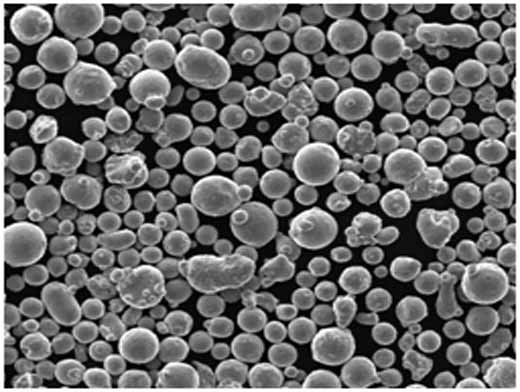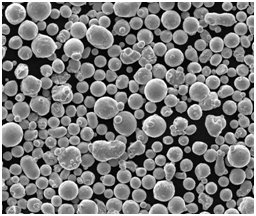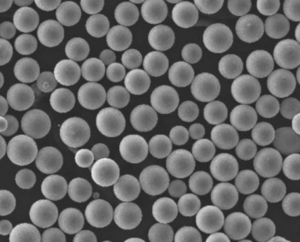Cuando se trata de aleaciones de alto rendimiento utilizadas en entornos extremos, Polvo Haynes 188 destaca como opción líder. Tanto si trabaja en el sector aeroespacial como en el de generación de energía o en cualquier otro sector que requiera materiales resistentes al calor extremo, el polvo Haynes 188 es famoso por su resistencia al calor, a la oxidación y a la fluencia. Pero, ¿qué hace que este polvo sea realmente único y por qué debería tenerlo en cuenta para su próximo proyecto de alta temperatura?
Esta completa guía le mostrará todo lo que necesita saber sobre el polvo Haynes 188. Exploraremos su composición, propiedades, aplicaciones e incluso compararemos otros polvos metálicos populares. Exploraremos su composición, propiedades, aplicaciones e incluso lo compararemos con otros polvos metálicos populares. Así que, abróchese el cinturón y sumerjámonos en el mundo de las superaleaciones con base de cobalto.
Visión general de la pólvora Haynes 188
Haynes 188 Powder es una superaleación con base de cobalto conocida por su excelente rendimiento a altas temperaturas. Se utiliza ampliamente en entornos en los que la resistencia a la oxidación y la estabilidad térmica son cruciales. La forma en polvo de Haynes 188 la hace ideal para la fabricación aditiva, permitiendo la creación de formas y componentes intrincados con facilidad.
Atributos clave:
- Excelente resistencia a la oxidación hasta 1095°C (2000°F)
- Buena resistencia a altas temperaturas
- Resistencia superior a la fatiga térmica
- Excelente resistencia a la fluencia y a la oxidación
- Ideal para la industria aeroespacial, turbinas de gas y revestimientos de cámaras de combustión
Usos comunes:
- Componentes aeroespaciales como quemadores y postcombustión
- Generación de energía aplicaciones
- Hornos industriales y recubrimientos de barrera térmica

Composición del polvo Haynes 188
La clave para entender por qué Haynes 188 Powder funciona tan bien reside en su composición. Esta aleación con base de cobalto se ha diseñado específicamente para resistir condiciones ambientales extremas.
| Elemento | Composición (%) |
|---|---|
| Cobalto (Co) | Saldo |
| Cromo (Cr) | 22.0 |
| Níquel (Ni) | 22.0 |
| Tungsteno (W) | 14.0 |
| Lantano (La) | 0.03 |
| Carbono (C) | 0.10 |
| Silicio (Si) | 0.35 |
| Manganeso (Mn) | 1.25 |
¿Qué hace especial a esta composición?
- Cromo mejora la resistencia del material a la oxidación y la corrosión.
- Níquel mejora la estabilidad general de la aleación a altas temperaturas.
- Tungsteno añade resistencia, especialmente en aplicaciones de alto calor.
- Lantano aumenta la resistencia a la oxidación y contribuye a la longevidad de la aleación.
Cada elemento se incluye estratégicamente para dotar a Haynes 188 Powder de sus capacidades de alto rendimiento, especialmente en entornos extremos.
Características del polvo Haynes 188
Ahora que sabemos lo que hay dentro de Haynes 188 Powder, veamos su características físicas y mecánicas.
| Propiedad | Valor |
|---|---|
| Intervalo de fusión | 1330°C – 1410°C |
| Densidad | 8.90 g/cm³ |
| Resistencia a la tracción a temperatura ambiente | 895 MPa (130 ksi) |
| Límite elástico a temperatura ambiente | 430 MPa (62 ksi) |
| Alargamiento | 45% |
| Dureza (Rockwell C) | 24 |
| Coeficiente de dilatación térmica | 12.8 μm/m°C (hasta 800°C) |
| Conductividad térmica | 10.7 W/m-K |
| Resistencia a la oxidación | Hasta 1095°C |
Características notables:
- Alta resistencia y ductilidad: Ofrece una resistencia mecánica superior combinada con una excelente ductilidad, por lo que es ideal para piezas sometidas a grandes esfuerzos.
- Estabilidad térmica: Soporta temperaturas extremas sin perder su integridad mecánica.
- Resistencia a la fluencia: La excelente resistencia a la fluencia garantiza que la aleación conserve su forma bajo una exposición prolongada al calor.
Aplicaciones de Polvo Haynes 188
Gracias a sus notables propiedades, el polvo Haynes 188 es una elección obligada en industrias en las que la resistencia al calor y la protección contra la oxidación son primordiales. Exploremos las industrias y aplicaciones específicas en las que esta superaleación realmente brilla.
| Solicitud | Detalles |
|---|---|
| Aeroespacial | Cámaras de combustión, postcombustión, toberas de escape, turbinas de gas |
| Generación de energía | Álabes de turbinas de gas, trayectorias de gases calientes, camisas de combustión |
| Hornos industriales | Componentes expuestos a altas temperaturas y entornos oxidativos |
| Fabricación aditiva (impresión 3D) | Fabricación de formas complejas para aplicaciones aeroespaciales y de generación de energía |
| Procesado químico | Intercambiadores de calor, reactores y otros equipos en entornos corrosivos |
En la industria aeroespacial, el polvo Haynes 188 se utiliza habitualmente en la fabricación de cámaras de combustión y secciones de turbina de motores aeronáuticos. Las centrales eléctricas también confían mucho en esta superaleación por sus excelentes propiedades de resistencia al calor.
Fabricación aditiva:
Una de las principales ventajas de Haynes 188 en forma de polvo es su adaptabilidad a la fabricación aditiva o impresión 3D. Esto permite la producción de piezas complejas de alto rendimiento con un mínimo de residuos, lo que lo hace rentable y respetuoso con el medio ambiente.






Modelos populares de polvo metálico: Haynes 188 Polvo y Alternativas
Comparemos la Haynes 188 con otros modelos populares de polvo metálico utilizados habitualmente en aplicaciones de alta temperatura.
| Polvo metálico | Composición | Propiedades notables | Aplicaciones |
|---|---|---|---|
| Haynes 188 | Co, Cr, Ni, W, La | Alta resistencia al calor y a la oxidación | Aeroespacial, generación de energía, hornos |
| Inconel 625 | Ni, Cr, Mo, Nb | Excelente resistencia a la corrosión y a la oxidación | Marina, procesamiento químico, reactores nucleares |
| Inconel 718 | Ni, Cr, Mo, Fe | Alta resistencia a la fatiga y a la fluencia a temperaturas elevadas | Motores a reacción, naves espaciales, turbinas |
| Haynes 230 | Co, Cr, W, Mo | Buena estabilidad térmica, resistencia a la oxidación hasta 1200°C | Aeroespacial, procesamiento químico, centrales eléctricas |
| Haynes 282 | Ni, Cr, Mo, Ti | Excelente soldabilidad y estabilidad térmica | Turbinas de gas, camisas de combustión |
| Hastelloy X | Ni, Cr, Fe, Mo, Co | Alta resistencia a la oxidación y buena conformabilidad | Componentes de motores a reacción, aplicaciones en hornos |
| Carburo de wolframio (WC) | W, C | Extrema dureza, alto punto de fusión | Herramientas de corte, aplicaciones resistentes al desgaste |
| Níquel 625 Polvo | Ni, Cr, Mo, Nb | Alta resistencia a la corrosión, soldabilidad | Procesamiento químico, industrias marinas |
| Estelita 6B | Co, Cr, W, Mo | Excelente resistencia al desgaste, tenacidad | Herramientas de corte, hojas de sierra, piezas de desgaste |
| Cromo cobalto | Co, Cr | Alta resistencia al desgaste, biocompatibilidad | Implantes médicos, aplicaciones dentales |
Ventajas del polvo Haynes 188
La pólvora Haynes 188 tiene muchas ventajas sobre otras pólvoras metálicas de alto rendimiento. Echemos un vistazo más de cerca a lo que la convierte en la opción superior en condiciones extremas.
1. Resistencia a altas temperaturas
En comparación con otras aleaciones, Haynes 188 destaca por mantener su resistencia en condiciones de calor extremo. Mientras que algunos materiales se ablandan a altas temperaturas, Haynes 188 puede soportar un funcionamiento continuo de hasta 1095 °C.
2. Resistencia a la oxidación
El alto contenido de cromo y níquel de la aleación le confiere una excelente resistencia a la oxidación, incluso en entornos extremos. Esto es crucial en industrias como la aeroespacial y la de generación de energía, donde los componentes están expuestos a atmósferas ricas en oxígeno a altas temperaturas.
3. Resistencia a la fluencia
En comparación con otras superaleaciones como Inconel 625 o Hastelloy X, Haynes 188 muestra mejor resistencia al deslizamiento. Esto significa que la aleación mantiene su integridad estructural incluso sometida a esfuerzos prolongados a temperaturas elevadas.
4. Versatilidad en la fabricación aditiva
Como polvo, Haynes 188 es especialmente adecuado para Impresión 3dla producción de piezas complejas y de alta precisión con un mínimo de residuos.
Limitaciones de Polvo Haynes 188
Por supuesto, ningún material es perfecto. Exploremos algunas de las posibles limitaciones del polvo Haynes 188.
1. Coste
Uno de los principales inconvenientes del polvo Haynes 188 es su coste. La presencia de cobalto y tungsteno hace que sea relativamente más caro que otras superaleaciones como Inconel 718. Sin embargo, las ventajas de longevidad y rendimiento suelen justificar el precio más elevado.
2. Soldabilidad
Aunque Haynes 188 puede soldarse, no ofrece el mismo nivel de soldabilidad que otras aleaciones con base de níquel
como el Inconel 625. Esto puede suponer un reto en aplicaciones que requieran mucho trabajo de soldadura.
3. Resistencia limitada a la corrosión
Aunque se comporta excepcionalmente bien a altas temperaturas, Haynes 188 no es tan resistente a la corrosión como otras aleaciones como Hastelloy X, especialmente en ambientes marinos o muy ácidos.
Especificaciones, tamaños, grados y normas de la pólvora Haynes 188
Estas son algunas de las principales especificaciones y normas asociadas a Polvo Haynes 188.
| Especificación | Detalles |
|---|---|
| Densidad | 8.90 g/cm³ |
| Intervalo de fusión | 1330°C – 1410°C |
| Tamaños estándar | Disponible en varios tamaños de malla para impresión 3D |
| Normas ASTM | ASTM F75, ASTM B637 |
| Grados típicos | AMS 5608, AMS 5801, AMS 5943 |
| Normas aplicables | ISO 9001:2015, AS 9100D, NADCAP |
Proveedores y precios de Haynes 188 Powder
Al comprar Polvo Haynes 188, es importante buscar proveedores de confianza para asegurarse de que adquiere un producto de alta calidad. A continuación se indican algunos proveedores conocidos y una estimación de sus precios.
| Proveedor | Gama de precios (USD/kg) | Región | Certificación |
|---|---|---|---|
| Tecnología Carpenter | $150 – $300 | EE.UU. | ISO 9001, AS 9100, NADCAP |
| Höganäs | $180 – $320 | Europa, Global | ISO 9001, AS 9100 |
| Praxair | $170 – $280 | EE.UU., mundial | ISO 9001, NADCAP |
| EOS | $200 – $350 | Alemania, Global | ISO 9001 |
| Kennametal | $160 – $310 | EE.UU. | AS 9100, ISO 14001 |
Los precios varían en función de factores como pureza, tamaño de las partículas, y certificaciones de proveedores. Los pedidos más grandes suelen recibir descuentos, y los servicios adicionales, como la mezcla personalizada o el tamaño de la malla, pueden aumentar el precio.
Ventajas e inconvenientes del polvo Haynes 188
A la hora de decidir si Polvo Haynes 188 es el material adecuado para su proyecto, es importante sopesar sus pros y sus contras.
| Pros | Contras |
|---|---|
| Excepcional resistencia al calor y a la oxidación | Relativamente caro en comparación con otros |
| Resistente a altas temperaturas | Resistencia limitada a la corrosión |
| Resistente a la fluencia | La soldabilidad no es tan fácil como en otras aleaciones |
| Ideal para la fabricación aditiva | Requiere manipulación y procesamiento especializados debido a su coste |

preguntas frecuentes
Aquí tiene una rápida sección de preguntas frecuentes para responder a algunas de las preguntas más comunes que la gente tiene sobre la pólvora Haynes 188.
| Pregunta | Respuesta |
|---|---|
| ¿Para qué se utiliza el polvo Haynes 188? | Se utiliza en la industria aeroespacial, la generación de energía y los hornos industriales, principalmente para componentes de alta temperatura. |
| ¿En qué se diferencia del Inconel 625? | Haynes 188 ofrece una mejor resistencia a la fluencia a altas temperaturas, mientras que Inconel 625 tiene una resistencia superior a la corrosión. |
| ¿Puede imprimirse en 3D la pólvora Haynes 188? | Sí, Haynes 188 Powder se utiliza habitualmente en la fabricación aditiva para piezas complejas y resistentes al calor. |
| ¿Es cara la pólvora Haynes 188? | Sí, debido a su composición (alto contenido en cobalto y wolframio), suele ser más cara que otras superaleaciones. |
| ¿Qué temperatura puede soportar Haynes 188? | Puede soportar temperaturas de hasta 1095°C (2000°F), lo que la hace adecuada para entornos extremos. |
| ¿Es Haynes 188 fácil de soldar? | Aunque puede soldarse, no es tan fácil de soldar como otras aleaciones con base de níquel, como el Inconel 625. |
| ¿Dónde puedo comprar polvos Haynes 188? | Se puede comprar a proveedores como Carpenter Technology, Höganäs y EOS. Los precios varían según el proveedor y el tamaño del pedido. |

